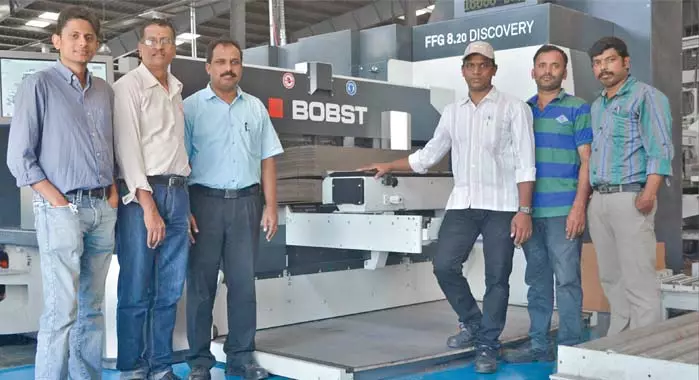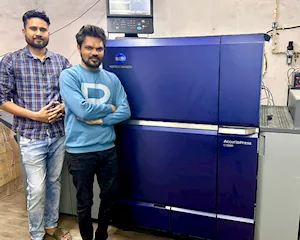The ‘simple but not easy’ recipe for a perfect brown box
Besides the right quality of paper and the precise heat control, you also need the right set of equipment and a higher degree of automation, as Rushikesh Aravkar learns firsthand at the shopfloor of the Printing and Packaging Division of the South India Paper Mills
09 May 2018 | By Rushikesh Aravkar
A world-record

Pratik Patel (l) and SIPM-PPD's production team along with the Bobst FFG
SIPM-PPD achieved the masterstroke of producing 1,06,113 boxes in eight hours on 19 September 2017. Patel says, “It was a regular day at work. We had to run five job changes in the shift. One of the jobs involved two-colour printing and the rest were single-colour jobs. In particular, one of the jobs was a beer carton box, which is a very lightweight board construction – 100gsm, three-ply board with B-flute. This kind of job adds more value to us as well as to our customers if processed at the fastest speeds with maximum accuracy, so that it runs flawlessly in the fast case-erecting and filling lines at the customer’s end.”
“Usually, we produce 75,000 to 85,000 cartons in one shift. In this particular shift, we achieved the average of 13,264 boxes per hour, including the set-up and cleaning time.”
In conversation | Manish Patel, managing director, SIPM

Has the business environment improved? How does one explain the new investments in the corrugation box industry?
The business environment hasn’t improved. The market is demanding certain quality of product and in order to cater to this demand, technology upgradation is required. Secondly, because of these investments and scales, the delivery times have shortened and hence you need converting machinery that deliver at same speeds. So these investments have come in as technological upgradation and should not be attributed to market growth.
What’s the market growth?
In my view, corrugation continues to grow at the rate of 8-10% per year. However, when investment levels go high and sophisticated technology comes in, you need high volumes to map this technology. Therefore, it is more likely that there will be fewer players with larger volumes. Consolidation is inevitable.
Please explain.
Today, the plant that has all the right equipment and automation in place needs an investment of not less than Rs 70-80 crore to convert up to 3,500 tonnes of paper into corrugated board per month. Now, when you put that much investment into one geographical location where there is box demand, each player is looking for large volumes to break-even. So, how many such plants can a particular region with certain amount of demand accommodate? This is important to understand. Today, the intensity of competition is rising. There is some momentum from the FMCG sector. However, these companies prefer to source from larger players who have capacities and capabilities to deliver faster.
Take Bengaluru, for example. The total market volume is in excess of 15,000 to 17,000 tonnes for automatic plants, as on now. Another 10,000 tonnes is converted by the conventional process. Today, the delivery order size has increased because the number of vendors that they are sourcing from has been cut down. If somebody needs, say 40,000 boxes in a day, earlier they used to have 12-14 vendors. Now, they have three to four vendors. Consolidation to that extent has happened.
So, what does one do to remain in the business?
For an existing player with semi-automatic operations, in order to remain in the business, he needs to make investments, which will allow him to match the scale that is expected in the market today. Now, if and when he decides to take the plunge, it is one more player in the pool. However, earlier he was converting 300 tonnes. Now, in order to break-even he needs to convert minimum of 1,000 tonnes. So unless people measure the market size and make conscious investment decisions, there will be aggressive competition.
With new technology, the quality of box improves, leading to optimisation of specifications and light-weighting. Does that mean the overall market will shrink?
Yes. Brand owners seek lighter and stronger boxes. While the box demand will continue to expand, the capacities in terms of corrugation speeds and conversion speeds have to increase. That’s because, ultimately, a corrugator is paid on the basis of the tonnage that he converts. So, one will not be able to generate that much contribution of conversion margin to sustain the costs and return-on-capital-employed numbers.
Does our industry need to seriously re-look at shopfloor operations to minimise the waste?
The wastage in an average corrugation plant in India is as high as 14-15% . One of the primary reasons is the poor quality of paper. Not just converting of paper into box, but manufacturing of good quality paper from the available raw materials is a big factor. This will determine the efficiency of the corrugation plants. If the good quality of paper is available, which runs on the corrugators with less wastage, minimum rejections, consistent performance then that corrugators will buy that paper.
Has our industry seen a shift in the manner in which contractual agreements are drawn between vendor and client?
The lack of transparency in the reverse auction is the bane of our industry. For a serious player in the market, it is important to know who he is bidding against. Just the name is adequate. If my fellow bidder is a reputed company which has the infrastructure to meet delivery requirements, then I know it’s a serious bid and it’s a fair game for us. However, many a times, a smaller company with inadequate capabilities also places the bid and even if that company doesn’t win the contract, it spoils the market.
Today, the market is fragmented and highly competitive. So much so that the prices of all the “worthy bidders” are almost the same. They are at the lowest possible numbers they can be at. The problem is new investments continue to happen, which is creating excess capacity of supply. So there are high chances that somebody, in a desperate bid to survive, will drag everybody down.
So how do you convince your customers?
The answer is value addition. There are technological solutions where you can use better paper, reduce cost, or shift down the specifications, so that the brand owners have an opportunity to save money. We educate the clients in terms of how they can improve their efficiency levels using correct kind of box. We also conduct productivity improvement and cost-saving projects with them.
Which is the emerging segment that will drive the corrugated box industry?
The fruit and vegetable sector will be a big driver. At the moment, the market is limited to exports. However, imagine when the local market also demands a corrugated box. We have worked on very lightweight models like 120gsm three-ply board with white top liner for printing graphics. In India, plastic crates are commonly used for shipping fresh produce. However, if you give them a solution that has low fungus count and bacterial count, lightweight and bring their costs down, then the farmers would be interested. The USP of these corrugated trays is that they are one fruit high. It enables transit protection and therefore reduces food wastage to a large extent. Again, we need to educate the stakeholders. We have to bring viability by bringing cost-effectiveness. Then there is tremendous potential.














 See All
See All